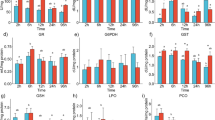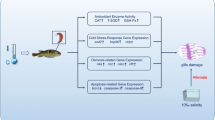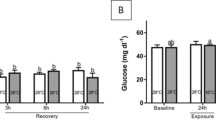Abstract
Water temperature is generally considered to be a major factor affecting the physiological and biochemical activities of marine bivalves. Here, the physiological and biochemical responses of Yesso scallop, Patinopecten yessoensis, to acute water temperature changes in summer were studied. Scallops were transferred directly to a lower temperature (Tdec treatment) (from 23°C to 15°C) or to a higher temperature (Tdec treatment) (from 15°C to 23°C) for 72 h, respectively. Results showed that the oxygen consumption and ammonia-N excretion rates of P. yessoensis decreased significantly in the Tdec treatment but increased dramatically at 6 h in the Tdec treatment (P <0.05). In the T dec treatment, hepatopancreas antioxidant enzyme activities, superoxide dismutase (SOD) and catalase (CAT) activities, increased substantially within 72 h (P <0.05). However, a significant decrease in CAT activity was found at 12 h in the Tdec treatment (P <0.01). A significant enhancement of acid phosphatase (ACP) activity and malondialdehyde (MDA) content was detected when scallops were acutely exposed to a temperature of 15°C. The levels of Cu/Zn-SOD gene expression in their gills up-regulated significantly in response to acute temperature changes (P <0.01). These data suggest that acute temperature change affects physiological and biochemical functions, and improve our knowledge of P. yessoensis under conditions of thermal stress.
Similar content being viewed by others
References
Abele D, Burlando B, Viarengo A, Pörtner H O. 1998. Exposure to elevated temperatures and hydrogen peroxide elicits oxidative stress and antioxidant response in the Antarctic intertidal limpet N acella C oncinna. Comparative Biochemistry and Physiology Part B: Biochemistry and Molecular Biology, 120 (2): 425–435.
Bao X B, Liu W D, Jiang B, Su H, Li Y F, Shan Z G, Yu H N, He C B. 2011. Expression stability of reference genes for quantitative PCR in Japanese scallop Patinopecten yessoensis. Fisheries Science, 30 (10): 603–608. (in Chinese with English Abstract)
Bao Y B, Li L, Xu F, Zhang G F. 2009. Intracellular copper/zinc superoxide dismutase from bay scallop Argopecten irradians: its gene structure, mRNA expression and recombinant protein. Fish & Shellfish Immunology, 27 (2): 210–220.
Bougrier S, Geairon P, Deslous–Paoli J M, Bacher C, Jonquières G. 1995. Allometric relationships and effects of temperature on clearance and oxygen consumption rates of Crassostrea gigas (Thunberg). Aquaculture, 134 (1–2): 143–154.
Boveris A, Cadenas E, Stoppani A O M. 1976. Role of ubiquinone in the mitochondrial generation of hydrogen peroxide. Biochemical Journal, 156 (2): 435–444.
Camus L, Grøsvik B E, Børseth J F, Jones M B, Depledge M H. 2000. Stability of lysosomal and cell membranes in haemocytes of the common mussel (Mytilus edulis ): effect of low temperatures. Marine Environmental Research, 50 (1–5): 325–329.
Chen M Y, Yang H S, Delaporte M, Zhao S J. 2007. Immune condition of Chlamys farreri in response to acute temperature challenge. Aquaculture, 271 (1–4): 479–487.
Cong M, Song L S, Wang L L, Zhao J M, Qiu L M, Li L, Zhang H. 2008. The enhanced immune protection of Zhikong scallop Chlamys farreri on the secondary encounter with Listonella anguillarum. Comparative Biochemistry and Physiology Part B: Biochemistry and Molecular Biology, 151 (2): 191–196.
Corner E D S, Cowey C B. 1968. Biochemical studies on the production of marine zooplankton. Biological Reviews, 43 (4): 393–426.
Fearman J, Moltschaniwskyj N A. 2010. Warmer temperatures reduce rates of gametogenesis in temperate mussels, Mytilus galloprovincialis. Aquaculture, 305 (1–4): 20–25.
Góth L. 1991. A simple method for determination of serum catalase activity and revision of reference range. Clinica Chimica Acta, 196 (2–3): 143–151.
Guo X M, Luo Y S. 2016. Scallops and scallop culture in China. In: Shumway S E, Parsons G J eds. Scallops: Biology, Ecology, Aquaculture, and Fisheries. Elsevier, Amsterdam, Netherlands. p.937–953.
Havas M, Rosseland B O. 1995. Response of zooplankton, benthos, and fish to acidification: an overview. Water, Air, and Soil Pollution, 85 (1): 51–62.
Hermes–Lima M, Storey J M, Storey K B. 1998. Antioxidant defenses and metabolic depression. The hypothesis of preparation for oxidative stress in land snails. Comparative Biochemistry and Physiology Part B: Biochemistry and Molecular Biology, 120 (3): 437–448.
Hermes–Lima M, Zenteno–Savı́n T. 2002. Animal response to drastic changes in oxygen availability and physiological oxidative stress. Comparative Biochemistry and Physiology Part C: Toxicology & Pharmacology, 133 (4): 537–556.
Ikeda T. 1974. Nutritional ecology of marine zooplankton. Memoirs of the Faculty of Fisheries, Hokkaido University, 22 (1): 1–97.
Jiang B, Bao X B, Zhang M, Gao X G, Li S L, Liu W D. 2011. Cu/Zn superoxide dismutase and its transcription expression analysis in Mizuhopecten yessoensis. Biotechnology Bulletin, (12): 150–156. (in Chinese with English Abstract)
Kehrer J P. 1993. Free radicals as mediators of tissue injury and disease. Critical Reviews in Toxicology, 23 (1): 21–48.
Kim K Y, Lee S Y, Cho Y S, Bang I C, Kim K H, Kim D S, Nam Y Y. 2007. Molecular characterization and mRNA expression during metal exposure and thermal stress of copper/zinc–and manganese–superoxide dismutases in disk abalone, Haliotis discus discus. Fish & Shellfish Immunology, 23 (5): 1 043–1 059.
Kosaka Y. 2016. Scallop fisheries and aquaculture in Japan. In: Shumway S E, Parsons G J eds. Scallops: Biology, Ecology, Aquaculture, and Fisheries. Elsevier, Amsterdam, Netherlands. p.891–937.
Lan S F. 1990. Hydrologic analysis of the death of scallops in sea area of Changshan Island in summer. Marine Sciences, 14 (2): 60–61. (in Chinese with English Abstract)
Le Moullac G, Haffner P. 2000. Environmental factors affecting immune responses in Crustacea. Aquaculture, 191 (1–3): 121–131.
Lesser M P, Bailey M A, Merselis D G, Morrison J R. 2010. Physiological response of the blue mussel Mytilus edulis to differences in food and temperature in the Gulf of Maine. Comparative Biochemistry and Physiology Part A: Molecular & Integrative Physiology, 156 (4): 541–551.
Lurman G J, Bock C H, Pörtner H O. 2007. An examination of the metabolic processes underpinning critical swimming in Atlantic cod (Gadus morhua L.) using in vivo 31 P–NMR spectroscopy. Journal of Experimental Biology, 210 (21): 3 749–3 756.
Matés J M, Sánchez–Jiménez F. 1999. Antioxidant enzymes and their implications in pathophysiologic processes. Frontiers in Bioscience, 4: D339–D345.
Mayzaud P, Conover R J. 1988. O:N atomic ratio as a toolto describe zooplankton metabolism. Marine Ecology–Progress Series, 45: 289–302.
Mayzaud P. 1973. Respiration and nitrogen excretion of zooplankton. II. Studies of the metabolic characteristics of starved animals. Marine Biology, 21 (1): 19–28.
Ni D J, Song L S, Gao Q, Wu L T, Yu Y D, Zhao J M, Qiu L M, Zhang H, Shi F F. 2007. The cDNA cloning and mRNA expression of cytoplasmic Cu, Zn superoxide dismutase (SOD) gene in scallop Chlamys farreri. Fish & Shellfish Immunology, 23 (5): 1 032–1 042.
Pilditch C A, Grant J. 1999. Effect of temperature fluctuations and food supply on the growth and metabolism of juvenile sea scallops (Placopecten magellanicus ). Marine Biology, 134 (2): 235–248.
Power A, Sheehan D. 1996. Seasonal variation in the antioxidant defence systems of gill and digestive gland of the blue mussel, Mytilus edulis. Comparative Biochemistry and Physiology Part C: Pharmacology, Toxicology and Endocrinology, 114 (2): 99–103.
Regoli F, Principato G. 1995. Glutathione, glutathionedependent and antioxidant enzymes in mussel, Mytilus galloprovincialis, exposed to metals under field and laboratory conditions: implications for the use of biochemical biomarkers. Aquatic Toxicology, 31 (2): 143–164.
Sadok S, Uglow R F, Haswell S J. 1999. Some aspects of nitrogen metabolism in Mytilus edulis: effects of aerial exposure. Marine Biology, 135 (2): 297–305.
Saucedo P E, Ocampo L, Monteforte M, Bervera H. 2004. Effect of temperature on oxygen consumption and ammonia excretion in the Calafia mother–of–pearl oyster, Pinctada mazatlanica (Hanley, 1856). Aquaculture, 229 (1–4): 377–387.
Somero G N. 2002. Thermal physiology and vertical zonation of intertidal animals: optima, limits, and costs of living. Integrative and Comparative Biology, 42 (4): 780–789.
Tian X L, Dong S L, Wang F, Wu L X. 2004. The effects of temperature changes on the oxygen consumption of juvenile Chinese shrimp Fenneropenaeus chinensis Osbeck. Journal of Experimental Marine Biology and Ecology, 310 (1): 59–72.
Van Der Have T M. 2002. A proximate model for thermal tolerance in ectotherms. Oikos, 98 (1): 141–155.
Vosloo A, Laas A, Vosloo D. 2013a. Differential responses of juvenile and adult South African abalone (Haliotis midae Linnaeus) to low and high oxygen levels. Comparative Biochemistry and Physiology Part A: Molecular & Integrative Physiology, 164 (1): 192–199.
Vosloo D, Van Rensburg L, Vosloo A. 2013b. Oxidative stress in abalone: The role of temperature, oxygen and L–proline supplementation. Aquaculture, 416–417: 265–271.
Vosloo D, Vosloo A. 2010. Response of cold–acclimated, farmed South African abalone (Haliotis midae ) to shortterm and long–term changes in temperature. Journal of Thermal Biology, 35 (7): 317–323.
Wang F Y, Yang H S, Gao F, Liu G B. 2008. Effects of acute temperature or salinity stress on the immune response in sea cucumber, Apostichopus japonic u s. Comparative Biochemistry and Physiology Part A: Molecular & Integrative Physiology, 151 (4): 491–498.
Wang X Q, Wang L L, Zhang H, Ji Q Z, Song L S, Qiu L M, Zhou Z, Wang M Q, Wang L L. 2012. Immune response and energy metabolism of Chlamys farreri under Vibrio anguillarum challenge and high temperature exposure. Fish & Shellfish Immunology, 33 (4): 1 016–1 026.
Wei K Q, Yang J X. 2015. Oxidative damage of hepatopancreas induced by pollution depresses humoral immunity response in the freshwater crayfish Procambarus clarkii. Fish & Shellfish Immunology, 43 (2): 510–519.
Wootton E C, Dyrynda E A, Ratcliffe N A. 2003. Bivalve immunity: comparisons between the marine mussel (Mytilus edulis ), the edible cockle (Cerastoderma edule ) and the razor–shell (Ensis siliqua ). Fish & Shellfish Immunology, 15 (3): 195–210.
Xiao J, Ford S E, Yang H S, Zhang G F, Zhang F S, Guo X M. 2005. Studies on mass summer mortality of cultured zhikong scallops (Chlamys farreri Jones et Preston) in China. Aquaculture, 250 (3–4): 602–615.
Zhang Z H, Li X X, Vandepeer M, Zhao W. 2006. Effects of water temperature and air exposure on the lysosomal membrane stability of hemocytes in pacific oysters, Crassostrea gigas (Thunberg). Aquaculture, 256 (1–4): 502–509.
Acknowledgement
The authors would like to thank WANG Junwei, WANG Senlin, and ZHANG Yitao of the Chudao Fishery Group for obtaining experimental animals and valuable technical support.
Author information
Authors and Affiliations
Corresponding author
Additional information
Supported by the National Natural Science Foundation of China (Nos. 41761134052, 41676147), the Central Public-interest Scientific Institution Basal Research Fund, YSFRI, CAFS (No. 20603022017019), the Director Project Financially Supported by Qingdao National Laboratory for Marine Science and Technology (No. QNLM201707), the Modern Agro-industry Technology Research System (No. CARS-49), and the Postdoctoral Applied Research Programs of Qingdao Municipal Government
Rights and permissions
About this article
Cite this article
Jiang, W., Du, M., Fang, J. et al. Response of Yesso scallop Patinopecten yessoensis to acute temperature challenge: physiological and biochemical parameters. J. Ocean. Limnol. 37, 321–329 (2019). https://doi.org/10.1007/s00343-019-7245-7
Received:
Accepted:
Published:
Issue Date:
DOI: https://doi.org/10.1007/s00343-019-7245-7




